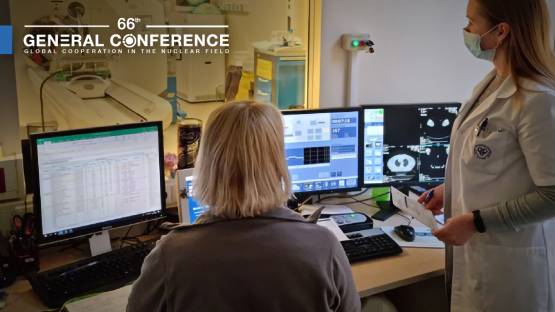While medical procedures using radiation save lives every day around the globe, strong national frameworks for radiation protection and safety are needed to ensure that patients and their caregivers are protected from unnecessary or unintended exposure.
Assessing and improving those frameworks in Europe and Central Asia was the focus on an event held today on the margins of the 66th IAEA General Conference. The event was attended by radiation protection and safety specialists, regulators and health professionals such as radiologists, nuclear medicine physicians and medical physicists.
Participants discussed how to enhance protection and safety of patients in medical uses of ionizing radiation, and ways of ensuring that every justified medical procedure is performed using the right dose to diagnose or treat disease.
They also considered the need for countries in the region to strengthen their national capacities to effectively implement the requirements of the IAEA’s safety standards on medical uses of ionizing radiation. Those requirements are presented in the Part 3 of the IAEA’s General Safety Requirements and provide a foundation for establishing regulatory frameworks with clearly defined responsibilities for radiation protection, including those for medical exposure of patients, carers and volunteers in programmes of biomedical research.
Since dose limits do not apply to patients who benefit from medical exposure, emphasis is placed on the requirements for justification and optimization of radiaton protection. Justification refers to every medical radiological procedure being appropriately selected according to the patient’s medical conditions, while taking into account the benefits and risks. Optimization refers to the management of the radiation dose, which should be commensurate with the medical purpose.
At the event, IAEA Radiation Protection Specialist Jenia Vassileva explained that an analyses of the national regulations of countries in the region showed medical exposure of patients and their caregivers had not been adequately included in the regulatory frameworks of some countries.
“In order to be successful, radiation protection should fit in with the larger system for providing high quality medical services,” said Vassileva. “This goal can only be achieved by establishing close collaboration between the regulatory body for radiation protection, health authorities and professional bodies in the field of healthcare.”
The panel discussed the challenges and common issues within regulatory frameworks related to medical exposure, such as insufficient coordination between relevant authorities and the insufficient integration of medical physicists, especially in diagnostic radiology which has an impact on quality assurance programmes, patient dose assessments and optimization.
Panellists described experiences from the first pilot advisory mission on radiation protection and safety in medical exposure, carried out in Estonia in March 2022, highlighting viewpoints of both the national regulatory authority and the end users. The nine-day mission provided a comprehensive assessment of the implementation of the IAEA Safety Standards related to exposure of patients, their carers and comforters at the national level, taking into account both regulatory and practical arrangements for radiation protection and safety specific to medical exposure.
During the mission, experts from Croatia, Finland, Italy, Ireland, Lithuania, and Slovenia reviewed national regulations and other written material and conducted interviews and site visits in close cooperation with the Estonia’s regulatory body, health authority, professional bodies and end users such as hospital staff. The mission offered an opportunity to test the methodology and guidelines of this upcoming advisory service, and the updated methodology will be used to design the next pilot later this year to continue strengthening patient safety in the use of ionizing radiation in medicine.
“From the viewpoint of health professionals, the new advisory missions on radiation protection and safety in medical exposure represents a valuable tool for the further improvement of radiation medicine and health care services,” said Professor Sergei Nazarenko, from Tallinn University of Technology in Estonia. “The mission provided recommendations, which in turn triggered a process to amend legislative acts and discuss their implementation in practice.”
Through its technical cooperation programme, the IAEA plays a key role in facilitating the improvement of national mechanisms to enhance radiation protection in medical exposure. The Agency provides expert missions, workshops and trainings to support strengthening the justification and optimization process and building of a safety culture. The Agency offers free online information and training resources, such as training material, webinars, reporting and learning systems such as Safety in Radiation Oncology (SAFRON) and Safety in Radiological Procedures (SAFRAD), all available from the Radiation Protection of Patients (RPOP) page.





